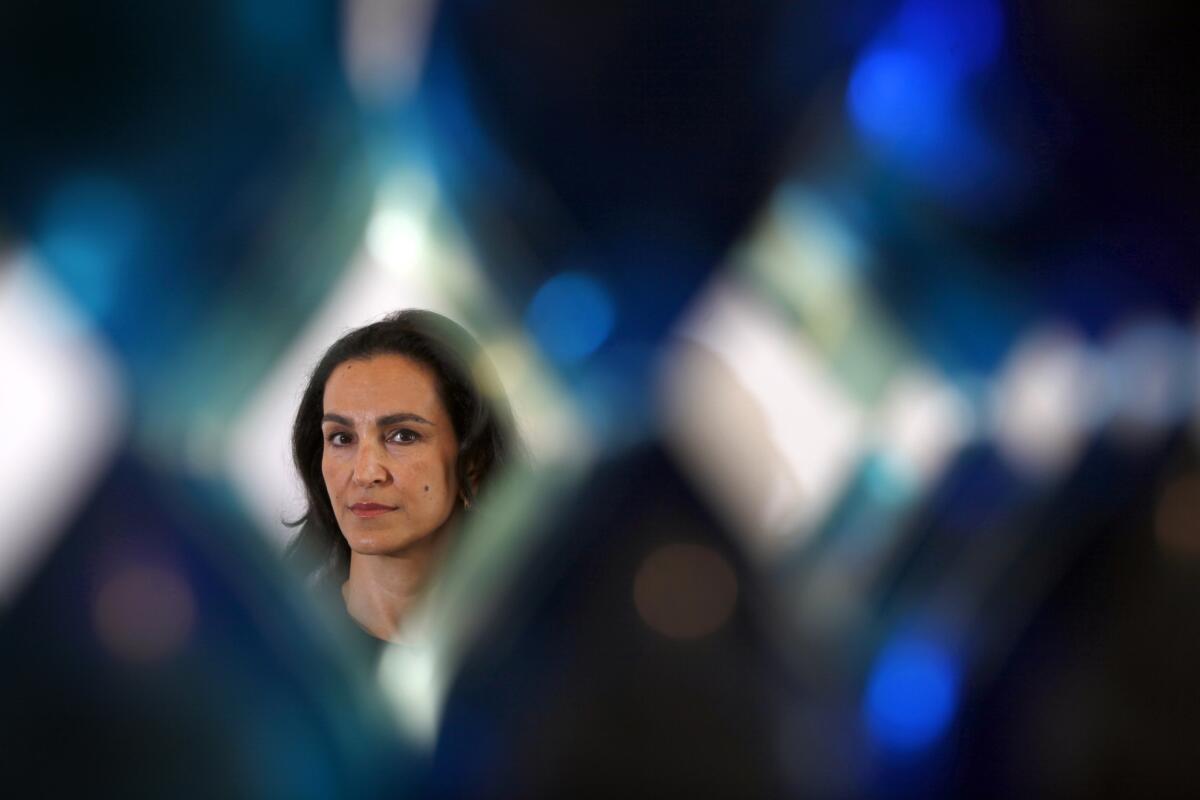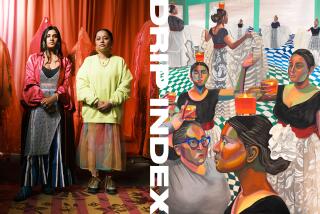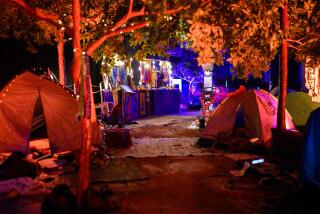Some ‘walk right out’ of L.A. gallery with Israeli, Iranian artists

Architect-turned-gallerist Shulamit Nazarian stretches out on the rooftop deck of her contemporary Venice art gallery, formerly a sleek Modernist house by the ocean.
The rooftop, five stories high with a fire pit at its center, is an oasis of peace on this Saturday afternoon: Potted grasses whip around in the warm, salty wind; children’s laughter and crashing waves reverberate below; barbecue smoke wafts over from a neighboring home.
It’s an unlikely setting for promoting world peace and global understanding between the historically embattled Arab and Israeli communities. But art is a powerful, universal language, Nazarian explains, her long, black hair and flowy white blouse rippling in the wind.
“Some people walk into our gallery — and walk right out,” she says. “But it’s a good thing, a great way to start a dialogue.”
As cultural tensions and political turmoil mount in the Middle East, Nazarian is attempting to “build bridges,” as she puts it, in her corner of the world. Shulamit Gallery, launched in 2012, is one of the few galleries in L.A. dedicated to showing contemporary Middle Eastern art and the only one in the city exclusively exhibiting the work of Iranians and Israelis side by side — artists of all religions and political affiliations — along with American Jewish artists. Through intimate group exhibitions, Nazarian aims to facilitate connections, physically and ideologically, between polarized Arab and Jewish communities as well as promote a better understanding of these cultures to Angelenos. As a Jew whose family immigrated to Los Angeles from Tehran when she was a teenager, Nazarian also sees the gallery as a reflection of her own identity.
“I’m basically showcasing artists that are part of who I am,” Nazarian says. “At the same time, it’s a great platform to promote understanding about — and between — these communities and show artists from different parts of the world.”
If the name Nazarian sounds familiar, that’s because Shulamit is the daughter of Younes and Soraya Nazarian, a prominent family who made more than $1 billion in the early ‘90s from investing in the tech industry. Her brother is night-life impresario Sam Nazarian, chief executive of the global hospitality and entertainment company SBE. The family’s nonprofit Y&S Nazarian Family Foundation in 2010 created the Center for Israel Studies at UCLA and endowed it with $5 million. So Nazarian has connections and a financial stability not usually found in the precarious and often-tumultuous art gallery world, where businesses come and go.
Her gallery, purchased in 2011 for $2.6 million, features glossy concrete floors, soaring ceilings and a flood of sunlight. Art hangs in every nook and cranny — in the hallways, throughout the airy kitchen, along the steel staircase railings. The wide-open ground floor is dedicated to special exhibitions and a multimedia project space for films and videos. The gallery occasionally provides grants and residencies to its artists.
“Having more money doesn’t mean things are easier; it means you have more responsibility to the community,” says Nazarian, who sits on the board of the Santa Monica Museum of Art and belongs to the Art of the Middle East Council at the Los Angeles County Museum of Art. “We take it very seriously in terms of what it means to give back.”
Since its launch, Nazarian has put up four group exhibitions and five solo shows. She represents American Jewish artist Gary Baseman, Israeli photographer Tal Shochat and Iranian American artist Pouya Afshar, and the gallery’s two inaugural exhibitions were part of the UCLA Fowler Museum’s 2012 “Light and Shadows: The Story of Iranian Jews,” an exhibition to which her family’s foundation was a major contributor.
This summer, “Centrifuge exhibited six Israeli artists — Jewish, Russian, Argentinean and Palestinian — on contemporary life in Israel, including the Ethiopian-Jewish experience and that of Latin American and African migrant workers. The gallery is currently showing “For Export Only,” an exhibition of sculpture, photography, mixed media works and a video installation by four Iranian artists in their 30s who now live elsewhere and whose work explores their morphing cultural identities.
Not all of the art at Shulamit is about the Middle East or being Jewish. Some of Baseman’s paintings feature his whimsical, colorful creatures, and Jonas N.T. Becker’s fluid, almost meditative video installations explored the idea of utopian desires. Pairing artists to spark dialogue, however, is one of Nazarian’s passions, she says. In 2013, Shulamit put up two shows, in adjacent spaces at the gallery, by American Jewish artist Doni Silver Simons and the Iranian Muslim-born Afshar, both of whom explored ideas of narrative folklore in their cultures.
Building bridges, however, can be tricky business, studded with road blocks. Reaction to the exhibitions has been generally positive, Nazarian says, but during “Centrifuge,” a drawing by Afshar that merged the faces of Yasser Arafat and Ariel Sharon angered Orthodox Jewish visitors. An exhibition of Israeli artists riled an Iraqi American visitor, who argued with Nazarian about the existence of Israel.
“We all have opinions, we all have sensitivities, we all have our ideas and understanding of the area,” Nazarian says of the Middle East. “Just be respectful of the other perspectives.”
The market for contemporary art coming out of Iran has been particularly hot since the mid-2000s, with a growing base of serious collectors there, says Linda Komaroff, head of LACMA’s Art of the Middle East Department. Major auction houses have moved into the region, including Sotheby’s Doha in Qatar in 2008 and Christie’s Dubai in the United Arab Emirates in 2006; a new Frank Gehry-designed Guggenheim Abu Dhabi planned to open in the UAE in 2017 will preview some of the works in its collection this November. A few galleries in L.A. are exhibiting contemporary Middle Eastern art, though that hasn’t yet translated into the same kind of demand for contemporary Middle Eastern art locally, Komaroff says.
“The scene in L.A. is in an early phase; if someone is serious about collecting contemporary Middle Eastern art, they’re going to go to London or Dubai or New York,” Komaroff says. “But I think Shula is filling a gap. She’s working from her passion and her interest, and you can’t go wrong there.”
Adds Homa Taraji of Tara Gallery, a nonprofit affiliated with the Santa Monica-based American Foundation for Contemporary Iranian Art: “I don’t think anyone else is doing exactly what Shula does. But you know, all of us who are showing Iranian art are saying: ‘Hey, Iran is not just what you hear in the news.’ Having contemporary art presented here shows another face of Iran.”
Nazarian travels to London, Israel and Dubai to find emerging Iranian artists, she says, and relies heavily on the Internet to find talent; but she doesn’t travel to Iran.
“I have such a strong connection with Israel, I think it would be politically very risky,” she says.
Providing Iranian artists with a safe haven for expression is also part of Shulamit’s mission. The gallery showcases all its artists on its website (shulamitgallery.com) but is careful when titling and describing works online that are directly critical of the Islamic government.
“[Some of] the work they show here is not the kind of work they can easily or freely show in Iran … satire or criticism of the Islamic government, sexuality and the feminine form,” Nazarian says, declining to name individual artists so as not to endanger them. “I want to create a space for them to expose their work freely, but at the same time, because the world is so Internet-connected, we have to be careful how much we put in the media.”
If Nazarian has found her purpose and creative niche, it’s been a long and circuitous search, she says. Her family left Tehran in 1978 just before the start of the Iranian Revolution when she was 15. Nazarian took just one suitcase of clothing, her diary and letters from pen pals in the U.K. and Japan. After a year in Israel, her parents moved to Beverly Hills, where Nazarian finished high school. The 90210 ZIP Code, however, “was a huge adjustment,” she says. “I was depressed for months.
“A lot of people didn’t know about Iran.... What they knew was what they saw on TV, the government and rioters, all very wild and crazy and disrespectful to America,” she says. “The ones that left Iran were the ones that didn’t agree with the government and wanted to be away from all that. But we still experienced a lot of ignorance and racism. We had good experiences … but we also had a lot of people who said, ‘Go back to your country.’”
Nazarian developed an interest in art and design from her mom, a sculptor, and in building from her dad, who had owned a factory manufacturing construction equiptment in Iran. She went on to study architecture at USC and Pratt in New York, where she graduated, had three sons with her first husband, real estate investor Raymond Torbati, and built her personal collection of contemporary art and antiques.
It wasn’t until after filing for divorce in 2005, however, that she found her calling.
Nazarian moved into her current home, the A. Quincy Jones-designed Marvin and Sandy Smalley House, in 2006. Friends of hers took note: With its walls of glass, natural light and swaths of empty wall space, it was the perfect space to showcase work by four Vietnamese painters from their family’s art gallery in Hanoi. Nazarian staged a pop-up exhibition for more than 100 people and sold about half the works in one night.
Over the next few years, Nazarian held additional art shows at her home, calling it Shulamit Gallery; in 2009, USC Hillel asked her to curate a group show of Iranian-Jewish contemporary artists, and that led to a pivotal turning point for her.
“I realized there was this huge vacuum, that our community didn’t understand much about Iranian contemporary art — a little more about Jewish and Israeli art, but less about Iranian,” she says. “And weren’t really aware of all these amazing artists that we had amongst us.”
With encouragement from her fiance, marketing executive Bruce Adlhoch, and a desire to reconnect with her own Iranian heritage (and because her children were tired of art events at their house), she bought the Venice building in 2011.
“For Export Only,” which runs through Nov. 1, includes new work as well as pieces that have been exhibited in Iran. Sanaz Mazinani’s installation of embossed stealth bomber plane formations on handmade white paper is delicate and flowery — a stark contrast to the colorful background it’s hung against, a kaleidoscopic view of Iranian mosque tile work.
Shahab Fotouhi’s large-scale photographs of Iranian waterfalls feature location notes in Farsi; superimposed over the images are TV transcripts of real political dialogues, the words erased and only cut-outs of punctuation marks remaining.
Mamali Shafahi’s 22-minute video installation is personal and political, an animated collage of his own childhood photographs and images he sourced online that remind him of growing up in Iran — all set to an original score of electronic music. “It’s chaotic, like life is in Iran,” he says.
“All of these artists grew up in Iran and experienced war and moved to other countries and had to adjust themselves, find their way in the arts,” curator Narges Hamzianpour says. “I saw that connection between their worlds, that perspective — and that was really attractive to me.”
On Oct. 9, Shulamit will host a young collectors evening at which some artists will be in attendance, and Hamzianpour will lead private tours of the work.
Mid-November, Shulamit will present a solo show by Iranian musician and performance artist Sussan Deyhim. It will feature four multimedia performance pieces inspired by Iranian feminist poet Forough Farrokhzad that the artist created as part of a Robert Rauschenberg Foundation residency. The exhibition will include framed photographs from previous performances, which are evocative of Amsterdam’s Red Light District, and a roster of new, live performances.
January will see a solo show by Jewish artist David Abir, an Iranian American whose light and sound installations were inspired by the negative space inside the Egyptian pyramids and the general spirit of ancient Middle Eastern culture.
Future shows will undoubtedly garner a prism of reactions, Nazarian suspects.
Regardless, she asks the same thing of all visitors: “Just be respectful; sometimes you have to agree to disagree.”
Follow me on Twitter: @DebVankin
More to Read
The biggest entertainment stories
Get our big stories about Hollywood, film, television, music, arts, culture and more right in your inbox as soon as they publish.
You may occasionally receive promotional content from the Los Angeles Times.











